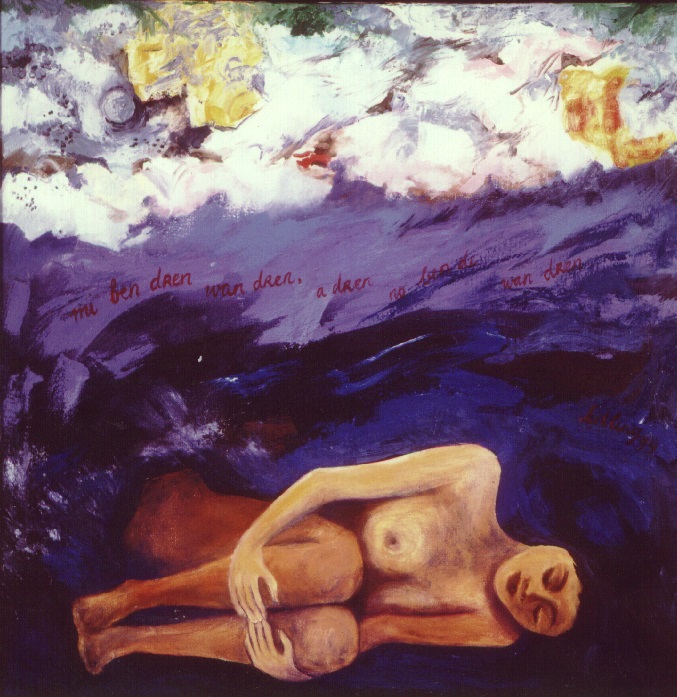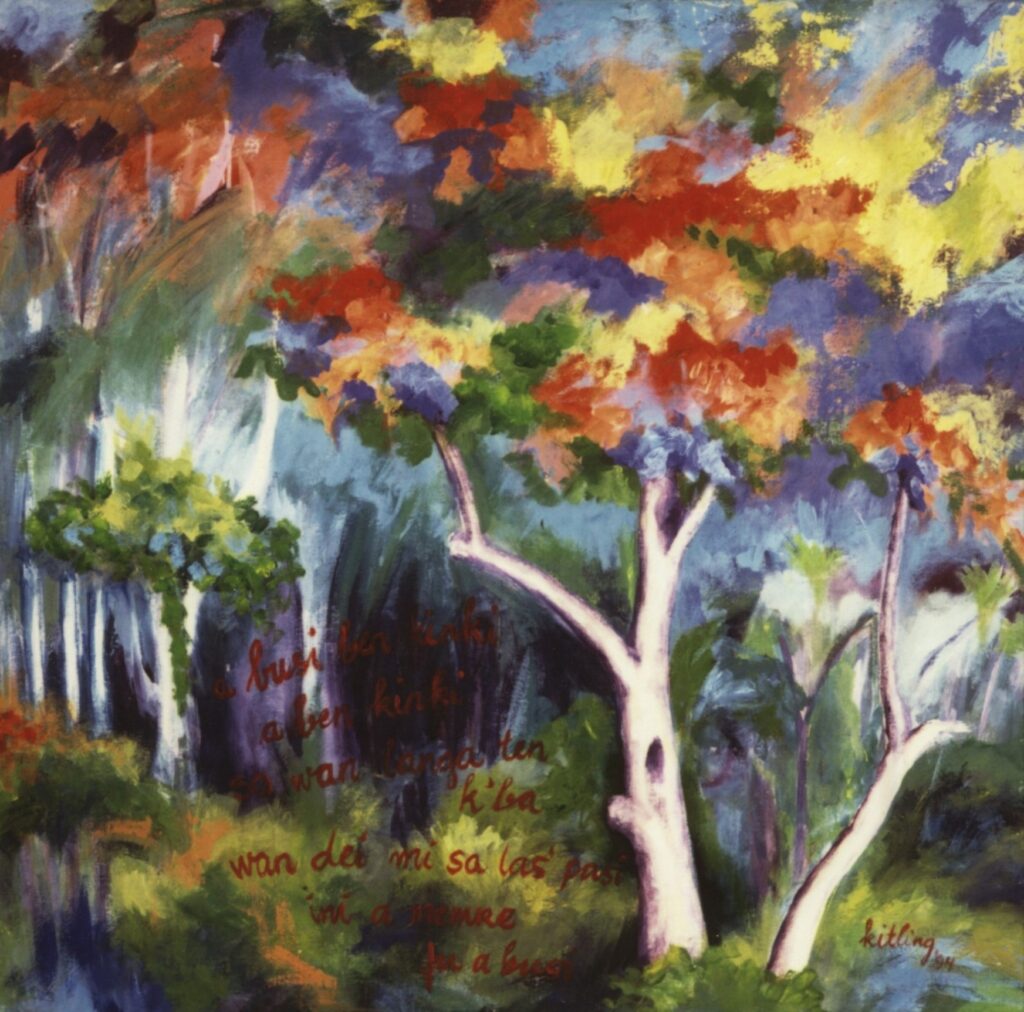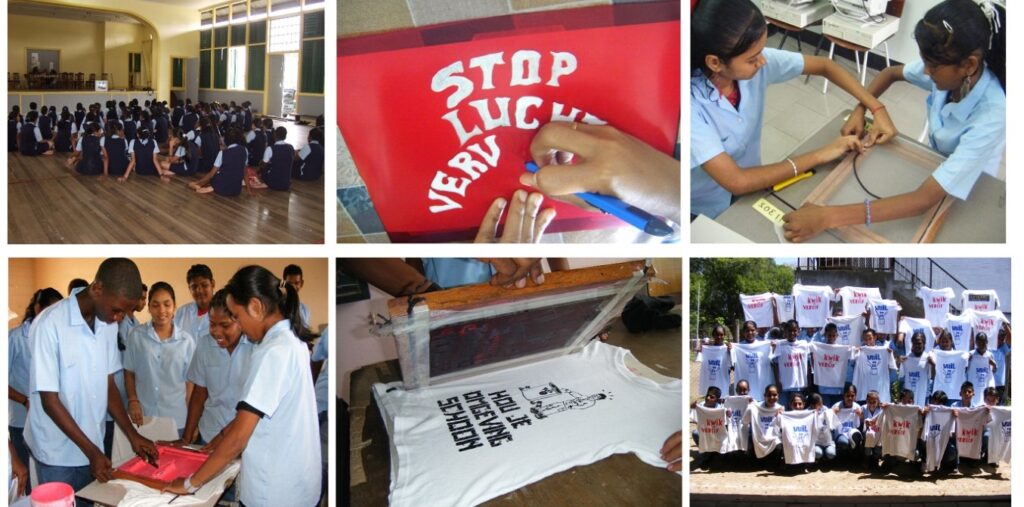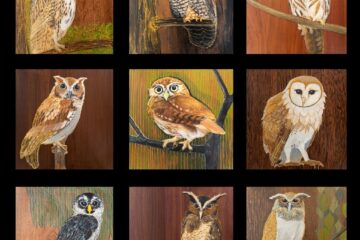In 1994, I made two paintings in which I wrote poems in Sranan Tongo, our native tongue.

Painting I: Oil on canvas, 80 x 80 cm
me ben dren wan dren
a dren no ben de wan dren
I had a dream
and it was not a dream

Painting II: Oil on canvas, 80 x 80 cm
a busi ben kinki
a ben kinki
so wan langa ten k’ba
wan dei mi sa las’ pasi
ini a memre fu a busi
the rainforest has changed
it already changed
a long time ago
one day I’ll be lost
in the memory of the rainforest
In 1998, we founded the Federation of Visual Artists in Suriname (FVAS).
We were a group of visual artists who were quite oriented on our Surinamese society. We wanted visual art to be of more importance in Suriname and made it a part of people’s daily life. As charter member, I became the secretary from the start until 2017. Within our social art and community projects, several educational art and environment projects were carried out. In the school year 2007 – 2008, the IDB Cultural Fund was the main sponsor of the program, and, in the school year 2008 – 2009, the project was financed by the UNESCO. George Struikelblok (vice-chair at that time) and I were the initiators, project developers and project managers all at the same time. Art and environment education were also part of a big art project in 2015, the PARAMARIBO – PIKIN SLEE – THE NETHERLANDS CONNECTION. This project was financed by the Dutch Embassy in Paramaribo and the GEF Small Grants Program of the UNDP. This project was again led by George Struikelblok (who, in the meantime, had become the FVAS chair) and I.

Educational Art and Environment project 2007 – 2008. Linocut Posters.
Now, in 2024, I think about the educational art and environment projects that were carried out in 2007, 2008 and 2009. When we were preparing the projects, we discovered that we were not the first who wanted to call attention to the environment with short informative videos. Stichting Schoon Suriname (Foundation Clean Suriname) and the National Institute for Environment and Development in Suriname (NIMOS) had already made TV spots that were being broadcast via our local TV stations. But what was the status of the awareness of the Surinamese people at that time? We went to various junior high schools (mulo) in Paramaribo and the districts with television and DVD sets. All different information videos about several kinds of pollution of the human environment were shown first. It was, among other things, about ‘garbage’, ‘mental pollution’, ‘hullabaloo’, ‘pollution of surface water’ (rivers, creeks, ditches), ‘pesticides’, ‘plastics’ (plastic bottles), ‘pollution of our tropical rainforest’, ‘recycling’, ‘global warming’. After these informative sessions, posters were made by using linocut and print techniques and printing T-shirts with a simple screenprint technique. But, once again, how much of this awareness we wanted to impart on them about our environment has stuck with those youngsters who are now all adults?

Educational Art and Environment project 2008 – 2009. Screenprint on T-shirts.
In 2008, I was also asked by Tanya Wijngaarde to write an article for our daily newspaper De Ware Tijd. The article was published in the quire ‘Swit Kontren’ and the headline was: “SURINAME, LAWAAIERIGE VUILNISBELT ALS TOERISTISCHE BESTEMMING” (SURINAME, NOISY GARBAGE DUMP AS TOURIST DESTINATION). The tourism sector was working intensively to promote Suriname as an attractive tourist destination and Suriname became one of the 10 best places to be, according to Lonely Planet in 2010. But, in 2008, the awareness of a clean and healthy environment needed for the development of tourism was not quite there yet.
In 2013, I won the Bridget Jones Travel Award. I travelled to Warwick, England, for the presentation of my essay “The Space In Between”. After this presentation, a white man in the audience said that he had paid a visit to Suriname and he considered Paramaribo a typical Dutch town in the Caribbean. Everything was so neat and clean. I did not have the chance to say or ask anything because the audience became a bit noisy here and there due to several displeased people. They thought of the remark as quite tendentious, as if the rest of the Caribbean was not clean. As a matter of fact, I was wondering when this man had come to Suriname. Had it been at the time when street sweepers equipped with brooms and rakes were in charge of keeping Paramaribo clean?
Today, I drove through a Paramaribo full of litter everywhere. I received a WhatsApp message that the government had not paid the garbage collecting service and that we would be saddled up with our own garbage. Now I keep thinking about:
- the impressive video shown in a solo exhibition of Marcel Pinas about the consequences of mercury poisoning by a little Maroon boy;
- the cyanide disaster in our neighboring country Guyana in 1995;
- the discussion about Mennonites in Suriname;
- carbon credits;
- National Socialism (Nazism) and the malignant narcissism of Hitler with his Clean Germany and antisemitism;
- the upcoming elections in 2025.
This is just one story with some thoughts and experiences about Art and Environment in Suriname.


